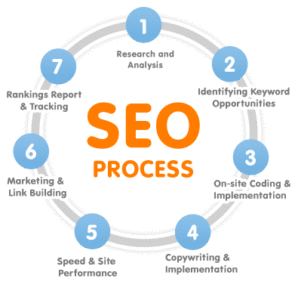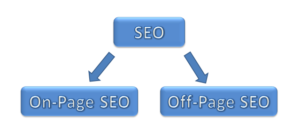SEO Explained: What is SEO and How Does It Work?
If you’ve ever asked yourself the question What is SEO?, you’re not alone. SEO, or Search Engine Optimization, is a complex process that can be difficult to understand. In this blog post, we’ll explain exactly what SEO is, how it works, and how you can use it to increase your website’s visibility and rankings in search engine results pages (SERPs). By the end of this post, you should have a better understanding of what SEO is and how it can be used to improve your website’s performance.
What is SEO?

Search engine optimization (SEO) is an essential part of digital marketing. It is the process of optimizing websites and other online content to appear higher on search engine result pages (SERPs). When people search for a particular term or phrase, the goal of SEO is to help ensure that your website is listed at the top of the SERPs for those keywords.
SEO is about more than just search engine ranking. It also involves making sure your website is optimized for users, improving page loading speed, and making sure all content is easy to find and easy to understand. To make your website more visible, you need to ensure that it’s properly optimized for search engine algorithms and keyword relevancy.
By employing SEO digital marketing tactics such as proper keyword research, creating quality content, and using link-building techniques, you can drive organic traffic to your website. SEO will also help your website rank higher in the SERPs and increase brand awareness. By leveraging the power of SEO digital marketing, you can give your website an edge over its competition and be found more easily by potential customers.
How Does SEO Work?

Search engine optimization (SEO) is the process of optimizing a website so that it performs better in search engine rankings. SEO involves making changes to the website’s content and structure, as well as other aspects such as site speed, mobile-friendliness, and user experience. In this section, we’ll explore how SEO works to improve your website’s visibility in search engine results.
First and foremost, SEO involves keyword research. Keywords are terms and phrases related to your business or website that potential customers are likely to use when searching for products or services like yours. By researching these keywords, you can learn what your customers are looking for, and use them to optimize your website.
Once you’ve identified keywords, you’ll need to incorporate them into your website content. This means creating quality content that features those keywords and provides useful information for users. For example, if you are a plumbing company, you might create blog posts about common plumbing problems and how to solve them. Not only will this content help potential customers find your website, it also provides a great user experience.
In addition to creating quality content, SEO also involves making sure that your website is easy to navigate and loads quickly. Search engines take into account how quickly your website loads and how easy it is to use, as these elements affect the user experience. Additionally, search engines reward websites that feature responsive design, meaning they adjust their layout based on the device used to view them.
By following these steps, you can increase the visibility of your website in search engine results and draw more potential customers to your website. Taking the time to properly optimize your website is an essential part of any digital marketing strategy.
Process of SEO step-by-step.

Search engine optimization (SEO) is an important aspect of digital marketing that helps websites achieve higher rankings in search engines. With SEO, you can create and improve the visibility of your website, increase organic traffic, and ultimately drive more qualified leads to your site.
But before we dive into the details of how SEO works, let’s discuss what it is. SEO is a set of techniques used to optimize web pages for higher rankings in search engine results pages (SERPs). It involves making changes to the Content, Structure, and Code of a website so that search engines can more easily discover and index the website’s content.
Now that we know the basics of SEO, let’s look at the process of SEO step by step.
- The first thing you need to do is figure out which keywords will help make your page rank well. You want these keywords to be targeted and relevant to your topic or industry, but don’t overdo it.
- Keywords should only comprise 20% of the text on your page!
- After deciding on which keywords are best suited for your page, work on creating content with those keywords in mind.
- Make sure the first sentence includes one of those words or phrases!
- After writing up some great content, start updating any necessary coding issues that might inhibit search engine crawlers from reading your information accurately.
- Now all there’s left to do is submit a sitemap file and wait until Google shows up on its own accord!
The Different Types of SEO

Search engine optimization (SEO) is an essential part of any successful digital marketing strategy. It’s the process of optimizing a website so that it ranks higher in search engine results, resulting in more organic traffic and leads. To understand how SEO works, it’s important to know the different types of SEO and how they can benefit your business.
First, let’s look at on-page SEO, which involves optimizing each page of your website for keywords related to your business. This includes adding relevant keywords to titles, headings, and content, as well as making sure your website is fast and mobile friendly. On-page SEO also involves optimizing meta tags, alt tags, and meta descriptions so they accurately describe what each page is about.
No.01
There is off-page SEO, which involves building links from other websites to yours. By linking to authoritative websites with content related to your business, you can increase your website’s authority and ranking in search engine results. Off-page SEO can also involve social media marketing, content marketing, and press releases.
No.02
There is technical SEO, which involves optimizing the backend of your website for better performance. Technical SEO includes creating a sitemap to make it easier for search engines to crawl your website, setting up 301 redirects if you need to change a URL, and improving page speed and loading times.
By understanding how SEO works, you can create a comprehensive digital marketing strategy that helps your business rank higher in search engine results and get more organic traffic. With the right combination of on-page, off-page, and technical SEO tactics, you can create an effective strategy that drives long-term success.
To Get Free SEO Consultation For Your Website/Brand
Call Us At +91 9599690396 or Visit:- www.digitalxperts.in

Leave a Comment